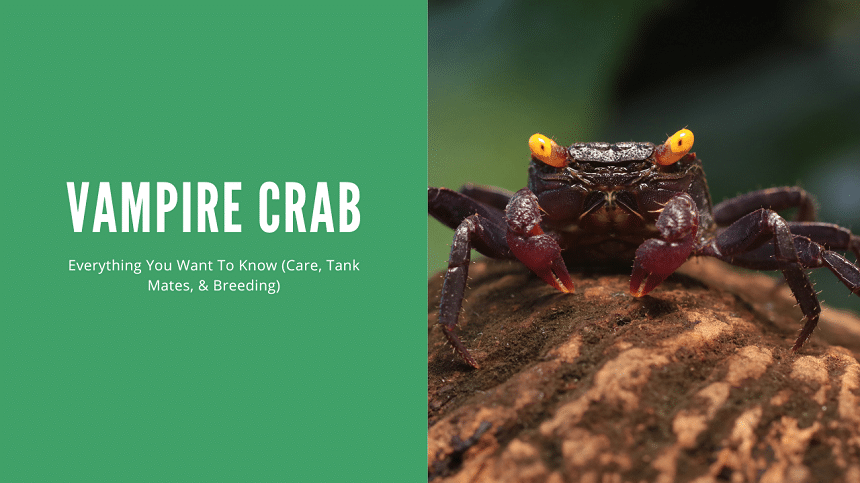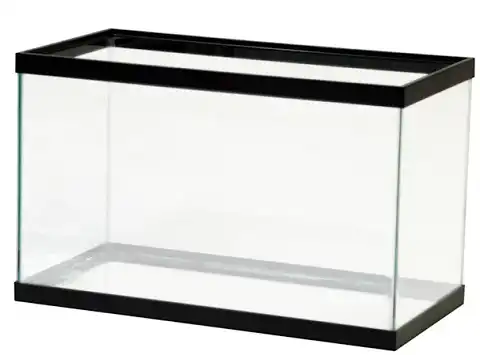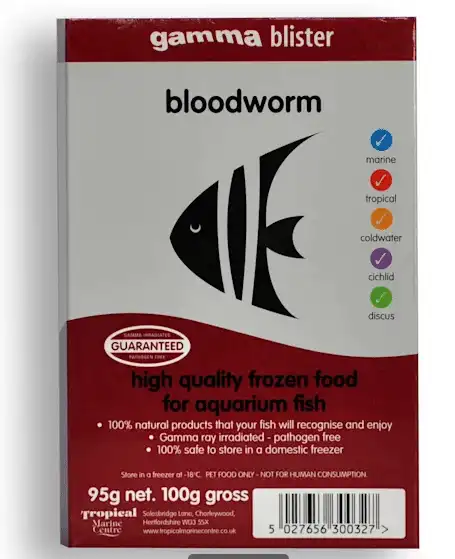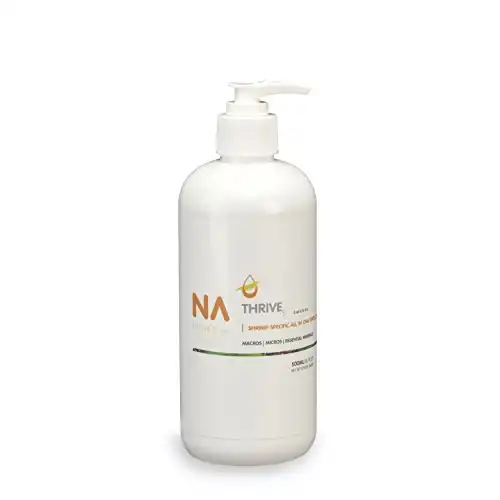Thank you for visiting! By the way… any links on this page that lead to products on Amazon and other stores/partners are affiliate links Aquarium Store Depot earns a commission if you make a purchase.
Discover the mesmerizing realm of vampire crabs! These eye-catching, secretive animals make remarkable additions to paludariums. Let’s explore together their needs for care, tank requirements, diet preferences, social dynamics and health management, all essential parts of keeping these fascinating creatures happy and healthy in captivity.
Key Takeaways
- Vampire crabs require a tank that has both land and water areas
- Vampire crabs prefer to be with live plants, perch, caves & rocks
- Vampire crabs enjoy water temperature from 75 – 82F (24-28C)
- Feed once a day with commercial shrimp to bloodworms & provide compatible tank mates for a safe living environment.
Overview of Species
| Scientific Name | Geosesarma dennerle |
| Common Names | Vampire Crab, Mini Crab, Red Devil Crabs, Carnival Crabs |
| Family | Sesarmidae |
| Origin | Southeast Asia (specifically Indonesia) |
| Diet | Omnivore |
| Care Level | Intermediate |
| Activity | Mostly active during the night (nocturnal) |
| Life Span | 2-3 years |
| Temperament | Generally peaceful, but males can be territorial towards each other |
| Tank Level | Semi terrestrial, with access to both land and water areas in the tank |
| Minimum Tank Size | 5 gallons (18 liters) for a single crab, larger if keeping a group |
| Temperature Range | 75-82°F (24-28°C) |
| Water Hardness | 0-10 dKH |
| pH Range | 6.0-7.5 |
| Filtration/Water Flow | Slow to Moderate |
| Water Type | Freshwater Tanks |
| Breeding | Egg Carrier |
| Difficulty to Breed | Moderate |
| Compatibility | Compatible with like-minded and like-sized fish species and inverts |
| OK, for Planted Tanks? | With Caution |
Understanding Them
Geosesarma dennerle, also known as vampire crabs (video from our official YouTube Channel), red devil crabs or carnival crabs, are nocturnal freshwater crustaceans found in the Indian Ocean. The Vampire Carb are small sized and have breathtaking beauty that make them an attractive addition to any aquarium. During daylight hours they hide away from the light, often staying motionless for many hours within their preferred spot – both on land and in water – before continuing to roam around their vampire crab tank at night time.
Origin and Natural Habitat
Vampire crabs live in the wild on the islands in the Indian Ocean like Java, Sulawesi and Riau as well as Krakatau, find their home in freshwater rivers and lakes across regions such as Southeast Asia and Indonesia that are typically hot & humid. They prefer shallow waters with an abundance of vegetation & land. Which closely resembles their natural habitat.
Live plants provide excellent shelter for these creatures while being protected from consumption by them – hence it’s a necessary part of vampire crab habitats. The Vampire crab needs soft sandy substrates beneath the surface so that breeding or molting can happen conveniently underground.
Physical Appearance
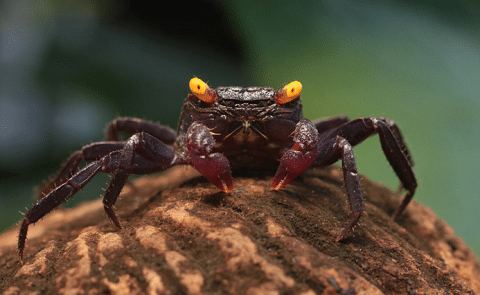
Vampire crabs stand out from other crab species due to their distinct deep purple hue on both their legs and bodies, lacing the color with white or cream spots. They are identified by yellow eyes and small pincers, plus male vampire crabs have lighter claws compared to those of the female vampire crabs. The latter can be done. Distinguished through an abdominal flap – a sharp one for males while it is wider yet rounder in females.
An amazing occurrence that vampire crabs go through is molting when old exoskeletons get discarded so as to grow new ones bigger than before. This also serves them protection against possible predators in nature’s wild areas.
Caring for Your Vampire Crab
The well-being of vampire crabs rests upon the environment they are kept in, which ideally should include a 10 gallon fish tank with an 80:20 ratio of land to water. This partially terrestrial habitat should also contain live plants and offer perching opportunities. Maintaining aquarium water within slightly alkaline water parameters is essential for their survival.
A quality filter, heater, and regular partial changes every month will ensure ammonia and nitrite levels remain undetectable – and keeps your nitrate levels low. The humidity level should remain at 75% or higher. Without proper care, the vampire crab cannot thrive as desired, so it’s very important that all aspects be taken into account when setting up the ideal space for them to inhabit safely!
Tank Setup and Environment
When it comes to setting up the ideal habitat for vampire crabs, a 10-gallon tank is the perfect size. The land/water ratio should be 80:20 with plenty of live plants, and somewhere they can perch – replicating their semi-terrestrial environment. Ensure there are enough hiding places in the form of caves or rocks so they feel safe.
Your standard 10 gallon tank. Goes on sale at local Petcos for cheap
Water Parameters and Maintenance
In terms of water parameters. pH levels from 7.5-8., temperature 24–28°C (75–82 °F). An efficient filter system as well as a heater and humidifier, will also come in handy in order to keep optimal quality standards maintained at all times.
Humidity levels are especially important for these aquatic creatures. Humidity needs to remain at or above 75%. To maintain this environment within the tank, a filter and heater should be purchased. Ammonia and nitrates should also be monitored regularly, with monthly partial water changes being performed in order to keep them under control.
Diet and Feeding
Vampire crabs are a great choice for aquarists that want to keep an easy-to-maintain pet. These omnivores need only one daily feeding and require minimal maintenance in their tanks, making them accessible for all aquatic enthusiasts. As scavengers, vampire crabs eat almost anything they find on the substrate, which adds variety to their diet. It is important not to forget to provide them with well balanced meals so as to ensure optimal health over time.
Food Options
For a balanced and healthy diet, vampire crabs should be provided with live and frozen foods as well as some dried options such as flakes, pellets, or algae wafers. Calcium-rich items like peas, spinach or broccoli are important for strong shell development in the animal. Other suitable food sources include brine shrimp feed along with earthworms, plus other meaty treats like bloodworms and crickets. Fruits, veggies, and natural plant matter can also provide variety to the vampire crab diet when fed on occasion.
Frozen bloods are a great source of protein and a fish source fish naturally respond to. Very filling and works for just about any fish
Feeding Frequency
Vampire crabs should be fed a well-balanced diet so they are given the necessary nutrition and energy on a daily basis. To accomplish this, a regular feeding routine should be established – establish an appropriate schedule for them so they can live healthy in their aquatic habitat.
If you keep up with consistent feedings of nutrients, it will lead to contentment within the crab population while also helping maintain good health levels as well! Feeding once a day should suffice for them.
Social Behavior and Tank Mates
Vampire crabs are sociable animals and can be quite aggressive if they feel threatened by other water-dwellers. So, it is important to make sure the tank mates for these creatures coexist peacefully with them as they tend to get along well among their own kind. A harmonious aquarium should be created so that vampire crabs stay contented in their environment. This means avoiding crab species or large carnivorous fish, which could create a hostile atmosphere towards them. In contrast, similarly sized passive fish can live in harmony with the vampire crabs without any problems arising from territorial issues.
Vampire Crab Compatibility
When keeping vampire crabs, it is vital to ensure that their tank mates are compatible. This crustacean species tends to be highly aggressive towards other crab species and larger fish.
Ideal Tank Mates
The best vampire crab tank mates should be similar in size and gentle fish that don’t present any danger. Other crab varieties must not join them since they might cause territorial issues among each other or lead to aggressive behaviors.
Fortunately, some aquarists have experienced great success pairing these creatures with smaller peaceful freshwater varieties such as:
- Neon Tetras
- Zebra Danios
- Freshwater shrimp
- Snails
- African Dwarf Frogs
- Other Vampire Crabs
If you select compatible companions for your vampires carefully, it will help create a harmonious atmosphere in their habitat which would consequently ensure good health, contentment, and longevity of these animals.
Breeding and Reproduction
Breeding vampire crabs can be an exciting and fulfilling experience for any aqua enthusiast. The breeding involves the male fertilizing eggs carried by female vampire crab around 30 days, then they hatch into independent babies that need to be isolated from their parents in order to avoid cannibalism.
Note there isn’t any established method of breeding available in the aquarium trade. Just keep your vampire crabs in optimal health, and they will generally attempt to breed on their own. That being said, Christoper Scott has a wonderful video on how to breed vampire crabs that could be helpful to you. Check out the video below:
Breeding Process
Breeding vampire crab is an intermediate level challenge. Male fertilization of the female’s eggs results in between 20 and 80 offspring, which will take roughly a month to hatch. To successfully breed these unique creatures, it’s necessary to provide adequate space, food sources and environment for them while closely observing the process.
Caring for Baby Crabs
Baby vampire crabs need to be housed away from adult vampire crabs and each other in order to avoid cannibalism. That’s correct – even the babies will attempt to eat each other!
Hideaway should be offered to the infant crustaceans so they can feel at ease during this sensitive stage and to ensure the survival of as many young vampire crabs as possible. The young vampire crabs must have a nutritious diet consisting of quality fish flakes, frozen brine shrimp or bloodworms. All given once daily will allow them to grow into healthy adults.
Common Health Issues and Prevention
The well-being of vampire crabs can be easily compromised, just like any other aquatic creature. Such health issues could include various parasites, bacteria and fungi. This is why it’s important to maintain a clean environment with the correct water parameters in order to help prevent these illnesses from occurring. By taking preventive steps such as isolating new specimens or providing them with balanced diets – you will minimize risks significantly of a disease outbreak into their habitat while keeping your crab population healthy and active!
Parasites, Fungal and Bacterial Infections
The health of vampire crabs can be compromised by various parasites, such as flukes, nematodes and ciliates. Fungal infections and bacterial issues are common as well. Because of their invert makeup, they are not susceptible some common fish diseases like white spot disease (ich).
To ensure the wellbeing of your pet you should keep up with regular water changes. If any outbreaks occur, make sure the medication used is safe for these inverts. Make sure they have adequate nutrition from a balanced diet in order to prevent any potential illnesses arising down the line for your beloved vampire crab(s).
Aside from illnesses, Vampire Crabs are very sensitive to copper and copper poisoning. If you have a planted tank, make sure the fertilizer you use does not contain copper. Many fertilizers that are designed for freshwater shrimp will be safe to use with vampire crabs.
An aquarium plant fertilizer specifically designed for shrimp tanks
Molting and Shell Health
Vampire crabs molt in order to grow, but this process can make them vulnerable. It is important for owners of these crustaceans to provide secure hiding places during the molt and practice good water quality standards as well as quarantine procedures. These practices will ensure their vampire crab pets remain healthy throughout life.
A nutritious diet that contains an ample amount of calcium needs to be provided so the exoskeleton stays strong and robust. Adding foods such as spinach or peas packed with this mineral into their meals is recommended, along with offering supplements if necessary.
Other Species To Check Out
Not sure if this crab is for you? Check out our other crab guides below:
Frequently Asked Questions
Are vampire crabs aggressive to humans?
Vampire crabs are quite territorial, often exhibiting aggressive behavior towards other vampire crabs and species. Nevertheless, the tiny claws on these little crustaceans pose no threat to humans. They make excellent additions to any aquarium as they offer a fascinating yet risk-free experience for all!
Are vampire crabs good pets?
Vampire crabs make amazing pets for newbies, as they are tough and easy to care for. Vampire crab behavior is known for being charming and energetic. They like climbing surfaces or taking refuge in dark corners also add an extra layer of interest to owning them! As long as you provide good nutrition and keep their environment clean, vampire crabs can be awesome little companions.
What’s a vampire crab?
Vampire crabs, one of nature’s most interesting creations, inhabit the Indonesian island of Java. These charismatic little animals live mostly on land, but they become particularly active around twilight when their big luminous eyes search for food. Their semi-terrestrial lifestyle and sinister common name make them a truly remarkable species!
What is the lifespan of a vampire crab?
When taken care of correctly, vampire crabs can have a lifespan up to two years. For optimal well-being, their tank should be at least 10 gallons in size and the temperature as well as pH levels needs to remain consistent throughout. If these water conditions are met properly, your pet crab is sure to enjoy an active and fulfilling life for two years!
Are Vampire Crabs aggressive to humans?
Vampire crabs may appear aggressive towards other species due to their territorial nature, yet they are harmless toward humans as their claws only possess minimal strength. Despite the small size of these creatures, caution should still be taken when interacting with them in order to avoid potential conflicts.
Closing Thoughts
At the end of the day, ensuring that your vampire crabs are healthy and happy requires thoughtful vampire crab care, a nutritious diet, compatible tank mates, and appropriate natural habitat for breeding.
Taking good observation practices seriously, along with caring deeply about these fascinating crustaceans, will help to build a harmonious space in which they can prosper. By learning more about the vampire crab, we can provide future generations of enthusiasts with advice on how best to look after their own vampire crab colonies, making sure everyone is able to enjoy life alongside this mysterious species.
- About the Author
- Latest Posts
I’m thrilled that you found Aquarium Store Depot! Here you’ll find information on fish, aquariums, and all things aquatics related. I’m a hobbyist (being doing this since I was 11) and here to help other hobbyists thrive with their aquariums! I adhere to a high quality Editorial Process and Review products with real life field usage and practical analysis.

